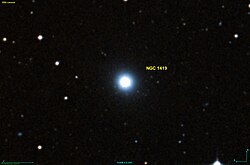NGC 1419 is an elliptical galaxy[4] located 62 millon light years away[2] in the constellation of Eridanus. The galaxy was discovered by astronomer John Herschel on October 22, 1835,[5] and is a member of the Fornax Cluster.[6] NGC 1419 is a host to a supermassive black hole with an estimated mass of 25 millon solar masses.[7]
| NGC 1419 | |
|---|---|
 DSS image of NGC 1419. | |
| Observation data (J2000 epoch) | |
| Constellation | Eridanus |
| Right ascension | 03h 40m 42.1s[1] |
| Declination | −37° 30′ 39″[1] |
| Redshift | 0.005240[1] |
| Heliocentric radial velocity | 1571 km/s[1] |
| Distance | 62 Mly (18.9 Mpc)[2] |
| Group or cluster | Fornax Cluster |
| Apparent magnitude (V) | 13.5[1] |
| Absolute magnitude (V) | −17.5[2] |
| Characteristics | |
| Type | E[1] |
| Mass | 6×109 (Total Mass)[3] M☉ |
| Size | ~25,300 ly (7.75 kpc) (estimated)[1] |
| Apparent size (V) | 1.1 x 1.1[1] |
| Other designations | |
| ESO 301- G 023, FCC 249, PGC 013534, MCG -06-09-017[1] | |
155 known globular clusters have been observed surrounding NGC 1419,[8] along with 21 planetary nebulae. These planetary nebulae reveal that the distance to NGC 1419 is approximately 18.9 Mpc, while measurements using surface brightness fluctuations reveal that NGC 1419 is approximately 22.9 ± 0.9 Mpc away. The measurements using planetary nebulae confirm that NGC 1419 is a member of the Fornax Cluster.[2]
See also
editExternal links
edit- NGC 1419 on WikiSky: DSS2, SDSS, GALEX, IRAS, Hydrogen α, X-Ray, Astrophoto, Sky Map, Articles and images
References
edit- ^ a b c d e f g h i "NASA/IPAC Extragalactic Database". Results for NGC 1419. Retrieved 2024-07-07.
- ^ a b c d Jacoby, George H.; Ciardullo, Robin; Roth, Martin M.; Arnaboldi, Magda; Weilbacher, Peter M. (2024-04-01). "Toward Precision Cosmology with Improved Planetary Nebula Luminosity Function Distances Using VLT-MUSE. II. A Test Sample from Archival Data". The Astrophysical Journal Supplement Series. 271 (2): 40. Bibcode:2024ApJS..271...40J. doi:10.3847/1538-4365/ad2166. ISSN 0067-0049.
- ^ Ding, Y.; Zhu, L.; van de Ven, G.; Coccato, L.; Corsini, E. M.; Costantin, L.; Fahrion, K.; Falcón-Barroso, J.; Gadotti, D. A.; Iodice, E.; Lyubenova, M.; Martín-Navarro, I.; McDermid, R. M.; Pinna, F.; Sarzi, M. (2023-04-01). "The Fornax3D project: Environmental effects on the assembly of dynamically cold disks in Fornax cluster galaxies". Astronomy and Astrophysics. 672: A84. arXiv:2301.05532. Bibcode:2023A&A...672A..84D. doi:10.1051/0004-6361/202244558. ISSN 0004-6361.
- ^ "Your NED Search Results". ned.ipac.caltech.edu. Retrieved 2024-07-07.
- ^ "New General Catalog Objects: NGC 1400 - 1449". cseligman.com. Retrieved 2024-07-07.
- ^ Ferguson, Henry C. (1989-08-01). "Population Studies in Groups and Clusters of Galaxies. II. A Catalog of Galaxies in the Central 3.5 Degrees of the Fornax Cluster". The Astronomical Journal. 98: 367. Bibcode:1989AJ.....98..367F. doi:10.1086/115152. ISSN 0004-6256.
- ^ Arzoumanian, Zaven; Baker, Paul T.; Brazier, Adam; Brook, Paul R.; Burke-Spolaor, Sarah; Becsy, Bence; Charisi, Maria; Chatterjee, Shami; Cordes, James M.; Cornish, Neil J.; Crawford, Fronefield; Cromartie, H. Thankful; Decesar, Megan E.; Demorest, Paul B.; Dolch, Timothy (2021-06-01). "The NANOGrav 11 yr Data Set: Limits on Supermassive Black Hole Binaries in Galaxies within 500 Mpc". The Astrophysical Journal. 914 (2): 121. arXiv:2101.02716. Bibcode:2021ApJ...914..121A. doi:10.3847/1538-4357/abfcd3. ISSN 0004-637X.
- ^ Lee, Sang-Yoon; Chung, Chul; Yoon, Suk-Jin (2019-01-01). "Nonlinear Color-Metallicity Relations of Globular Clusters. VIII. Reproducing Color Distributions of Individual Globular Cluster Systems in the Virgo and Fornax Galaxy Clusters". The Astrophysical Journal Supplement Series. 240 (1): 2. arXiv:1811.00018. Bibcode:2019ApJS..240....2L. doi:10.3847/1538-4365/aaecd4. ISSN 0067-0049.